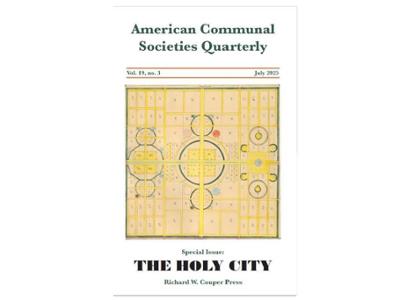Publications
-
One year subscription to the American Communal Societies Quaterly
-
Two year subscription to the American Communal Societies Quaterly
-
American Communal Societies Series, no. 19. 256 pages, 2025.
ISBN: 978-1-937370-43-5 ($40)In response to the trauma of industrialization and urbanization in the late-nineteenth century, the Arts and Crafts Movement took America by storm. Art exhibits, workshops, and societies dedicated to handicraft, worker dignity, and the production of beautiful art for the masses sprouted from California to Boston. Ralph Radcliffe Whitehead, Elbert Hubbard, and William Lightfoot Price were so enamored with the movement that they decided to build entirely new worlds—intentional communities—dedicated to pursuing those ideals. Englishman Whitehead founded an art colony named Byrdcliffe in New York’s Catskill Mountains. Hubbard, a former soap salesman, established an Arts and Crafts community business, Roycroft, outside Buffalo, New York. Price, an architect, built the Rose Valley Association outside Philadelphia. They endeavored to reform the economic and social inequalities of industrial capitalism through communal living, artistic development, craft, and the sale of finely crafted furniture, architecture, metalwork, and more. This was what they believed was living “the art that is life.” For these community members, this meant producing and selling art with a social message as well as living everyday life as if it was a work of art. In imagining a compromise between machine-dominated industry and handicraft, these artisans sought to critique industrial capitalism and carve out a space where craftspeople could once again flourish in community. Rose Valley, Byrdcliffe, and Roycroft were total sensory installations of the Arts and Crafts Movement that stood as community-workshops that were an alternative to brutal industrialization.
Thomas A. Guiler (Ph.D., Syracuse University) is the director of museum affairs at the Oneida Community Mansion House in Oneida, New York. He was assistant professor of history and public humanities at the Winterthur Museum, Garden & Library in Wilmington, Delaware. He also served at the president of the Communal Studies Association. He has published on the history and material culture of intentional communities such as Oneida and of the Arts and Crafts Movement.
-
- From the Editor
- New Light on the Holy City
- "Explanation of the Holy City," 1843
Front cover illustration: Anonymous, The Holy City, 1843 (detail). Gift of Mr. and Mrs. Julius Zieget, 1963. Accession no. 1963-160-5. Philadelphia Museum of Art.
Back cover illustration: Fountain stone, Shirley, Massachusetts, late-nineteenth century. Photograph. Communal Societies Collection, Hamilton College.
-
- From the Editor
- The Gospel of Thomas Hammond
- A Reconsideration of the Neal(e) Family
- “Blanche to Church all alone”: Canterbury’s Evolving Religious Praxis
Front cover illustration: The Qui Vive Quartette (sisters Jennie Fish, Jessie Evans, Josephine Wilson, and Helena Sarle) often performed at venues across the region.
Courtesy of Canterbury Shaker Village.
Back cover illustration: Frederick Demont visiting his aunts at the Ann Lee Cottage, c. 1938. Seated: Sarah Neale, Emma Neale, Ethel May Demont Peterson holding Douglas Lee Peterson, Neale Lawrence Peterson. Courtesy of Canterbury Shaker Village. -
American Communal Societies Series, no. 18. 362 pages, 2025
ISBN: 978-1-937370-42-8 ($40)
The utopian socialism of Charles Fourier inspired the most popular and influential communal movement during America’s pivotal “utopian moment” in the pre-Civil War era. Far from a colorful curiosity, the Fourierists were serious participants in the debate over the future of the young republic. This collection of essays supplements Carl Guarneri’s award-winning earlier volume on the Fourierists by examining such topics as Emerson’s private fascination with Fourierism, the experience of women in Fourierist communities, and the utopian socialists’ relation to slavery and the Civil War. Pursuing unexplored affinities and connections, Guarneri demonstrates the Fourierists’ influence on the free-love Oneida Community, documents exchanges between American and European social reformers, and situates the Fourierist movement in the larger context of American, transatlantic, and communal history.
Carl Guarneri is Brother James Ash Professor of History, Emeritus at Saint Mary’s College of California and Affiliated Scholar in History at Colgate University. He has published a dozen books on utopian socialism, the Civil War, and American history in global context, as well as numerous articles and reviews. His earlier volume on the utopian socialists, The Utopian Alternative: Fourierism in Nineteenth-Century America (1991), was awarded the annual book prize of the Society for Historians of the Early American Republic. Guarneri received the Communal Studies Association’s Distinguished Scholar Award in 2006.
-
- From the Editor
- “God loves such a building”: Three Diagrammatic Shaker
- Drawings at Library of Congress by Carol Medlicott
- Alpha and Omega: The 1804 Shaker Church of Christ
- Missionary Letter and Richard McNemar’s 1838 Response by Christian Goodwillie
- Document: “The Church of Christ,” 1804
- Document: Church of Christ as printed by Richard McNemar, ca. 1831
- Document: Richard McNemar, Draft of an Answer, ca. 1838
- Document: BIGOTRY.
Front cover illustration: Drawing of three Shaker buildings. For reasons that are not clear, this drawing was catalogued together with, “A Plan of Alfred, Maine,” by Joshua H. Bussell, 1845. Library of Congress Call Number G3734.A432 1845.B8.
Back cover illustration: BIGOTRY. Ear Am 20, Book Collection, Harry Ransom Center, The University of Texas at Austin -
American Communal Societies Series, no. 17. 260 pages, 2024
ISBN: 978-1937370411 ($30)Who was Dr. Alesha Sivartha, the visionary artist whose strange inscribed mind maps, occult diagrams, and painstaking anatomical drawings were printed in a variety of obscure books and pamphlets in the late nineteenth century?
Religious historian John Buescher here draws Dr. Sivartha out of mysterious obscurity and traces the story of his wild life, from his birth as Elisha Holmes Dodge in upstate New York in 1834, to his transformation, under the name of Arthur E. Merton, into a phrenologist, free-lover, utopian socialist, and cult leader. At the time of his death in 1915, he had assumed the name of Alesha Sivartha, and transformed himself into an occult documentarian who sought to map the structures of the “New Jerusalem” onto the biological and chemical world. This richly illustrated volume includes an extensive album of Sivartha’s drawings.Dr. John B. Buescher is the author of books and articles on the history of nineteenth-century American Spiritualism. He is a co-director of the International Association for the Preservation of Spiritualist and Occult Periodicals (IAPSOP).
-
- From the Editor
- Rabbit Heads, Indian Maidens, and a Can of Peas: Entertainments with the Canterbury Shakers by Rebecca Soules
- Canterbury Takes the Lead by Stephen J. Paterwic
- White Water Shaker Society Burial Grounds by Beth J. Parker Miller
- Document: We Appeal to the Sovereign People by Christian Goodwillie
Front cover illustration: At Easter 1932, members of the Junior Orchestra pose in front of the Canterbury water tower in their rabbit masks and vests. (CSV P0271)
Back cover illustration: Judith, with Sister Marguerite Frost onstage amongst a forest of potted trees and painted backdrops. (CSV 2-PN299) -
- From the Editor
- How Father Joseph Emerged as the Leader of the Shakers: A Closer Look at the 1780s and Beyond by Stephen Paterwic
- “Fall on the rock”: Excavating a Shaker Spiritual Motif by Carol Medlicott
- “The Picturesque Shakers” and “Hands to Work: Picturing the Shakers as Handicraft Workers in 19th Century Photographs” by Robert P. Emlen
- The Grand Survivor: The Harvard Shakers’ New Office of 1839–40 213 by Ned Quist
Front cover illustration: “J. W.” Stone. Photo by Winthrop B. Coffin, The Peg Board, 1936. Back cover illustration: The grave marker of Sarah Wright Meacham, mother of Father Joseph Meacham. Photo by author.







